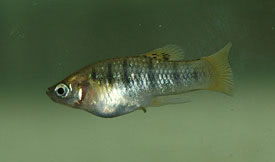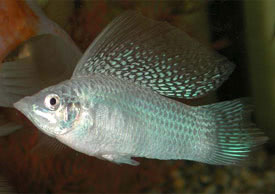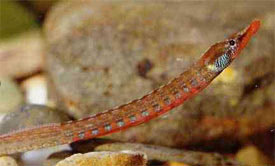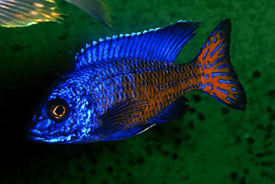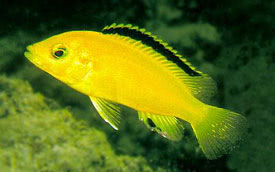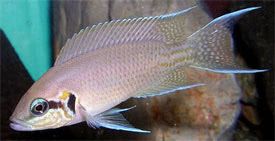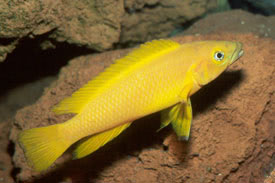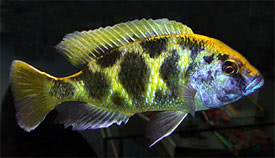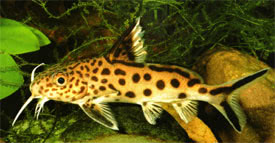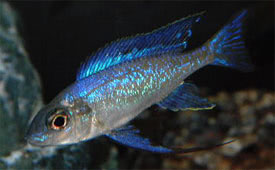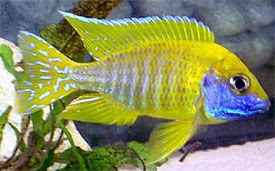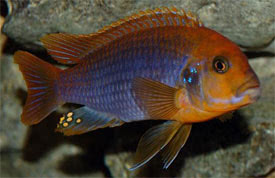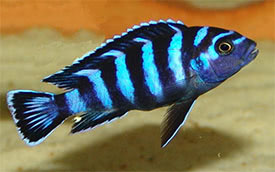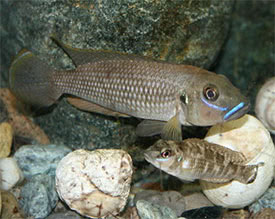
 Magyarul / Hungarian
Magyarul / Hungarian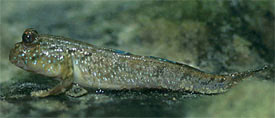
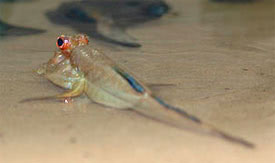
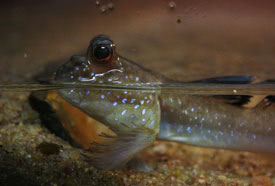


- Scientific name: Periophthalmus barbarus
- Synonyms: Gobius barbarus, Gobius koelreuteri, Peiophthalmus erythronemus, Periophtalmus koelreuteri, Periophthalmus gabonicus, Periophthalmus koelreuteri, Periophthalmus papilio
- Common name: Atlantic Mudskipper
- Group: Brackish fishes
- Habitat: West Africa; from Mauritania to Angola
- Size: 15 cm
- Biotope: Inhabits in brackish waters of African river estuaries and mangrove swamps, in the tidal areas.
- Social behavior: Highly territorial with conspecifics, and males are incredibly territorial with one another. Do not combine with small fish as they may be eaten. They need a species tank.
- Diet: Carnivorous; they eat chiefly live foods. All types of worms, insects, invertebrates and small fish. They eat frozen foods as well.
- Breeding: Breeding is not difficult under the proper conditions.
- Tank: Minimum 120 litres
- Population: 4-5 fish for 500 litres
- Decoration: The tank must have dry areas, sandy beach is suggested or perhaps partially emerged mangrove roots or piled rocks. The air should be very humid and the temperature should be the same as the water, so a tight-fitting cover suggested. The substrate should be coral sand. Use plants that can tolerate brackish water such as mangrove.
- Temperature: 25-30 °C
- pH: 7-8,5
- Hardness: 10-25 NK°
- Salinity: 10-20g salt /10 litres
- Lifespan: 5-8 years
Description: Their color is usually olive green to brown with oblique dark bars, while the belly is white to blue. They have sky blue speckles on flanks, which are larger and more numerous on snout. The base of the fins are brown turning to blue with a red or white fringe. The snout is flattened at the front and the eyes are set high on the head giving the charming appearance of a frog. They keep their eyes moist with their pectoral fins. They can quickly recognise their keeper and can easily be trained to feed from the hand. Mudskippers will not tolerate acidic water conditions. The depth of water level should not exceed 30 cm. Purchase only a single specimen if space is limited, in a large aquarium a group of 5 or more can be kept. A minimum of 60 x 30 cm territory space per fish is advisable. Atlantic Mudskippers will leave water for long periods of time, but their gills must remain moist at all times. Some fish like to stay in the shallow water, while others prefering to rest completely exposed on rocks. Atlantic Mudskippers use their pectoral fins in water for swimming and on land for walking. They can also do small jumps with the tail is bent forwards and to the side. Mudskippers are highly territorial and during a territorial encounter they often use their attractively coloured dorsal fins to display or "flagging" at each other. After this dominant fish may resort to physical violence. Serious damage can occur and this is why no more than a single male specimen should be kept in most set-ups.
Males are usually larger and have notably more colourful finnage during the breeding season. The fish are impossible to breed, because their habitat is difficult to imitate in an aquarium. Periophthalmus barbarus spawns once a year from February to May. In nature the males dig up to 1 m deep tunnels in the mud, where spawning and broodcare takes place. The eggs are laid in the deepest chamber of this pit and the female guards the young once they hatch.







